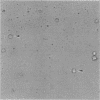Abstract
Following the diagnosis of Acanthamoeba keratitis in a contact lens wearer, the antimicrobial susceptibility of the clinical isolate and the environmental source of the infection were investigated. Contrary to previous reports, in vitro antimicrobial testing showed that the infecting strain was inherently resistant to propamidine isethionate. Restriction endonuclease digestion analysis of Acanthamoeba whole-cell DNA of strains isolated from the patient's cornea, contact lens storage container, saline rinsing solution, and kitchen cold-water tap showed that the isolates were identical. This implicates, for the first time, domestic tap water as the source of Acanthamoeba sp. in this infection. It is therefore recommended that the use of homemade saline solutions and the rinsing of contact lenses in tap water be strongly discouraged.
Full text
PDF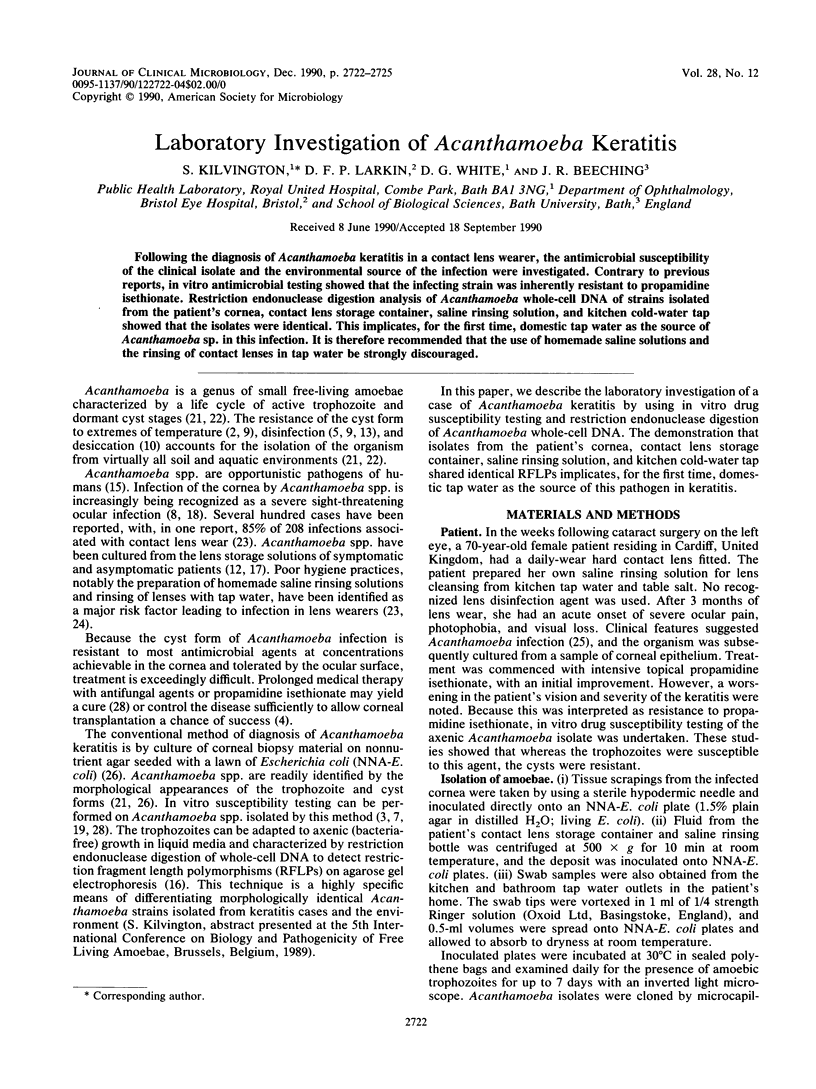
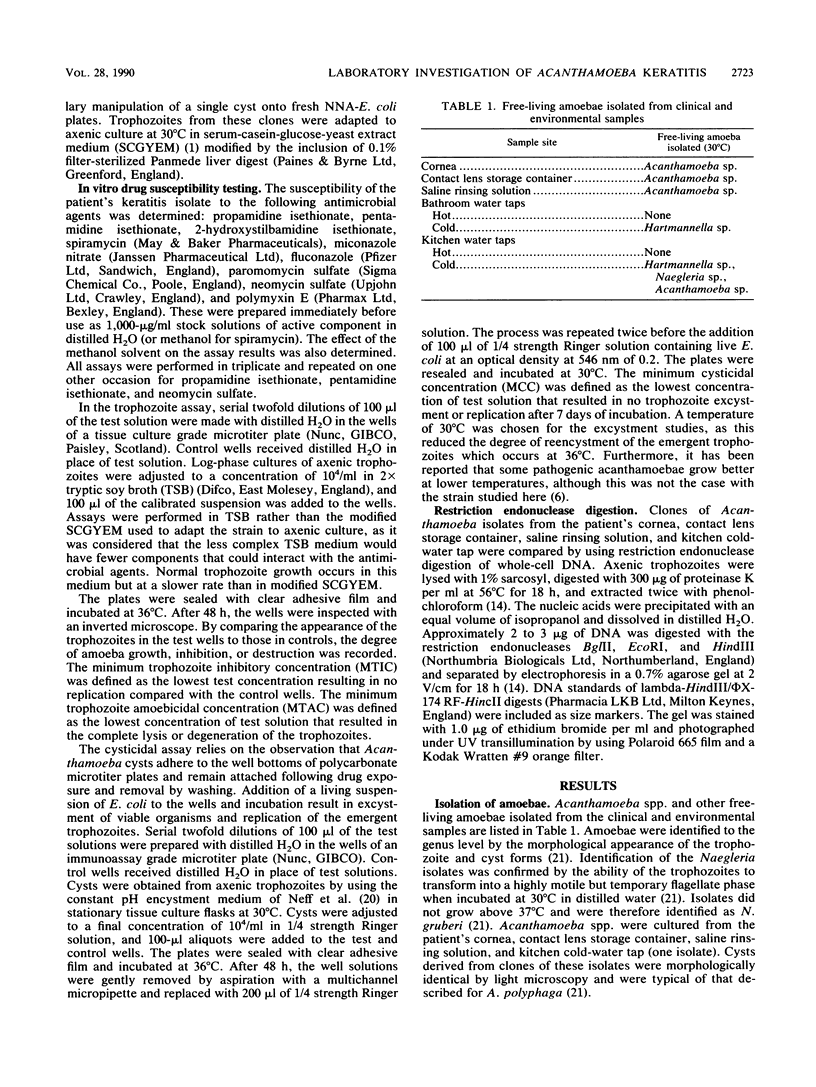
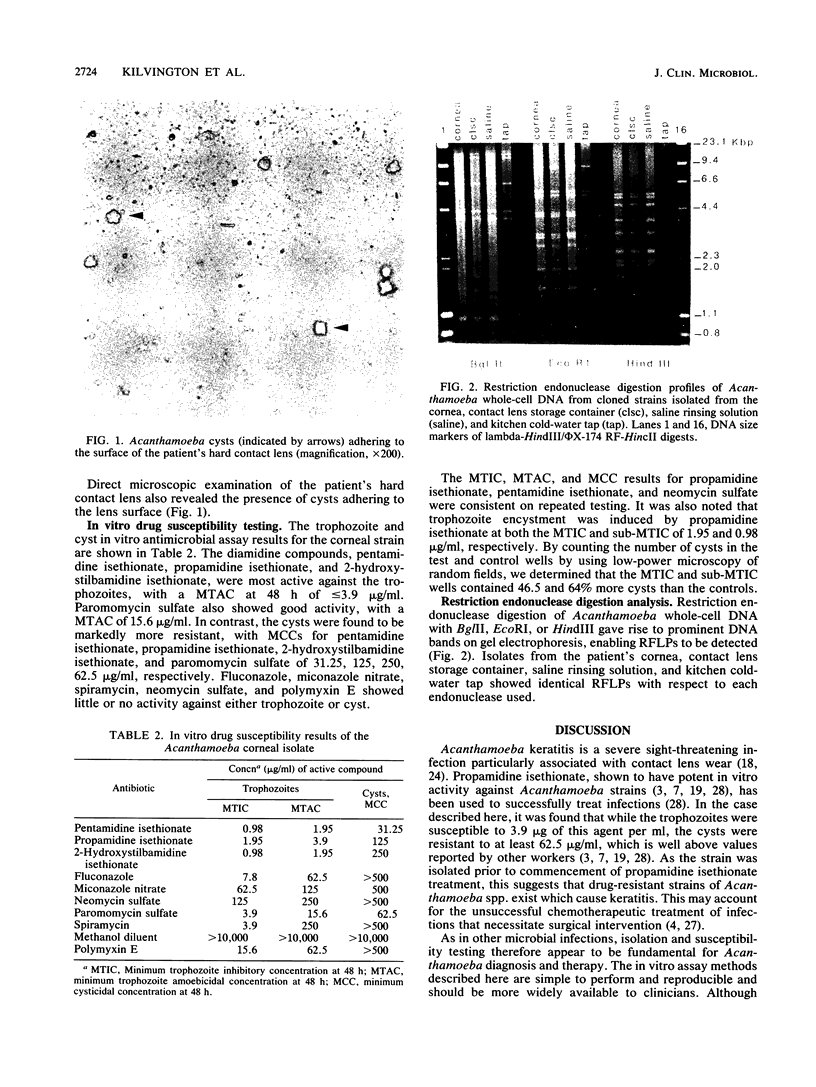
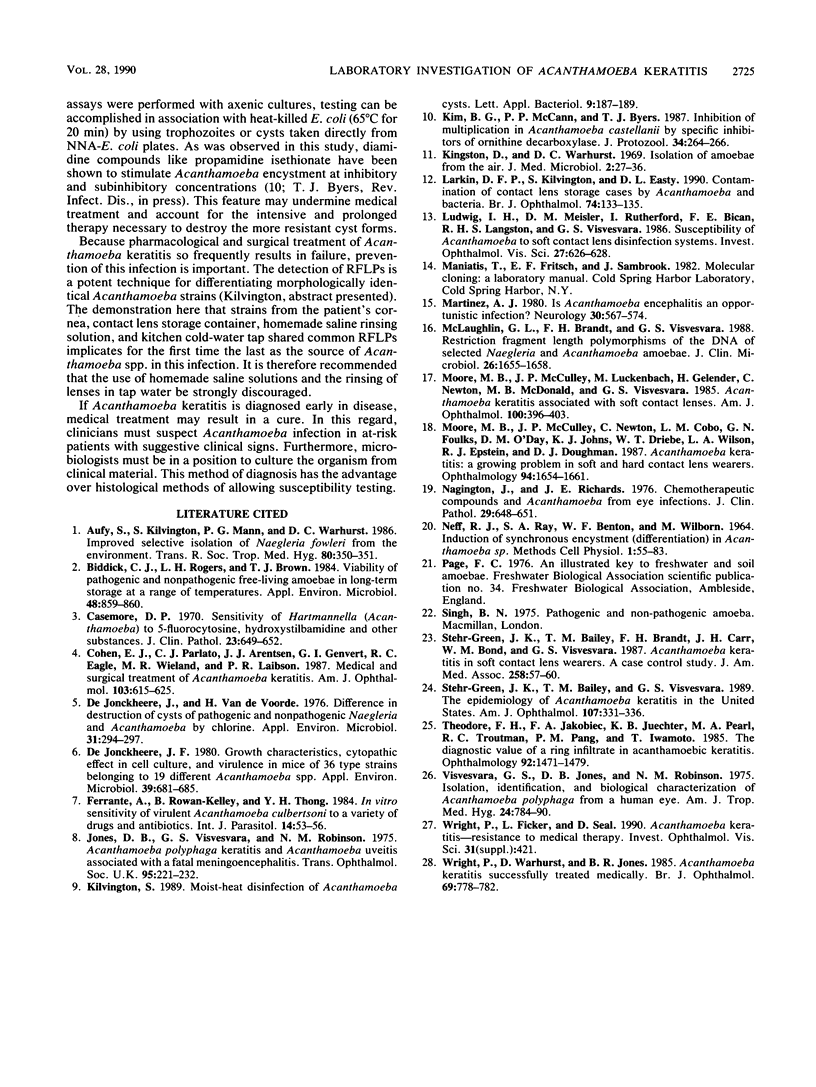
Images in this article
Selected References
These references are in PubMed. This may not be the complete list of references from this article.
- Aufy S., Kilvington S., Mann P. G., Warhurst D. C. Improved selective isolation of Naegleria fowleri from the environment. Trans R Soc Trop Med Hyg. 1986;80(2):350–351. doi: 10.1016/0035-9203(86)90060-x. [DOI] [PubMed] [Google Scholar]
- Biddick C. J., Rogers L. H., Brown T. J. Viability of pathogenic and nonpathogenic free-living amoebae in long-term storage at a range of temperatures. Appl Environ Microbiol. 1984 Oct;48(4):859–860. doi: 10.1128/aem.48.4.859-860.1984. [DOI] [PMC free article] [PubMed] [Google Scholar]
- Casemore D. P. Sensitivity of Hartmannella (Acanthamoeba) to 5-fluorocytosine, hydroxystilbamidine, and other substances. J Clin Pathol. 1970 Nov;23(8):649–652. doi: 10.1136/jcp.23.8.649. [DOI] [PMC free article] [PubMed] [Google Scholar]
- Cohen E. J., Parlato C. J., Arentsen J. J., Genvert G. I., Eagle R. C., Jr, Wieland M. R., Laibson P. R. Medical and surgical treatment of Acanthamoeba keratitis. Am J Ophthalmol. 1987 May 15;103(5):615–625. doi: 10.1016/s0002-9394(14)74320-x. [DOI] [PubMed] [Google Scholar]
- De Jonckheere J. F. Growth characteristics, cytopathic effect in cell culture, and virulence in mice of 36 type strains belonging to 19 different Acanthamoeba spp. Appl Environ Microbiol. 1980 Apr;39(4):681–685. doi: 10.1128/aem.39.4.681-685.1980. [DOI] [PMC free article] [PubMed] [Google Scholar]
- De Jonckheere J., van de Voorde H. Differences in destruction of cysts of pathogenic and nonpathogenic Naegleria and Acanthamoeba by chlorine. Appl Environ Microbiol. 1976 Feb;31(2):294–297. doi: 10.1128/aem.31.2.294-297.1976. [DOI] [PMC free article] [PubMed] [Google Scholar]
- Ferrante A., Rowan-Kelly B., Thong Y. H. In vitro sensitivity of virulent Acanthamoeba culbertsoni to a variety of drugs and antibiotics. Int J Parasitol. 1984 Feb;14(1):53–56. doi: 10.1016/0020-7519(84)90011-0. [DOI] [PubMed] [Google Scholar]
- Jones D. B., Visvesvara G. S., Robinson N. M. Acanthamoeba polyphaga keratitis and Acenthamoeba uveitis associated with fatal meningoencephalitis. Trans Ophthalmol Soc U K. 1975 Jul;95(2):221–232. [PubMed] [Google Scholar]
- Kim B. G., McCann P. P., Byers T. J. Inhibition of multiplication in Acanthamoeba castellanii by specific inhibitors of ornithine decarboxylase. J Protozool. 1987 Aug;34(3):264–266. doi: 10.1111/j.1550-7408.1987.tb03172.x. [DOI] [PubMed] [Google Scholar]
- Kingston D., Warhurst D. C. Isolation of amoebae from the air. J Med Microbiol. 1969 Feb;2(1):27–36. doi: 10.1099/00222615-2-1-27. [DOI] [PubMed] [Google Scholar]
- Larkin D. F., Kilvington S., Easty D. L. Contamination of contact lens storage cases by Acanthamoeba and bacteria. Br J Ophthalmol. 1990 Mar;74(3):133–135. doi: 10.1136/bjo.74.3.133. [DOI] [PMC free article] [PubMed] [Google Scholar]
- Ludwig I. H., Meisler D. M., Rutherford I., Bican F. E., Langston R. H., Visvesvara G. S. Susceptibility of Acanthamoeba to soft contact lens disinfection systems. Invest Ophthalmol Vis Sci. 1986 Apr;27(4):626–628. [PubMed] [Google Scholar]
- Martínez A. J. Is Acanthamoeba encephalitis an opportunistic infection? Neurology. 1980 Jun;30(6):567–574. doi: 10.1212/wnl.30.6.567. [DOI] [PubMed] [Google Scholar]
- McLaughlin G. L., Brandt F. H., Visvesvara G. S. Restriction fragment length polymorphisms of the DNA of selected Naegleria and Acanthamoeba amebae. J Clin Microbiol. 1988 Sep;26(9):1655–1658. doi: 10.1128/jcm.26.9.1655-1658.1988. [DOI] [PMC free article] [PubMed] [Google Scholar]
- Moore M. B., McCulley J. P., Luckenbach M., Gelender H., Newton C., McDonald M. B., Visvesvara G. S. Acanthamoeba keratitis associated with soft contact lenses. Am J Ophthalmol. 1985 Sep 15;100(3):396–403. doi: 10.1016/0002-9394(85)90500-8. [DOI] [PubMed] [Google Scholar]
- Moore M. B., McCulley J. P., Newton C., Cobo L. M., Foulks G. N., O'Day D. M., Johns K. J., Driebe W. T., Wilson L. A., Epstein R. J. Acanthamoeba keratitis. A growing problem in soft and hard contact lens wearers. Ophthalmology. 1987 Dec;94(12):1654–1661. [PubMed] [Google Scholar]
- Nagington J., Richards J. E. Chemotherapeutic compounds and Acanthamoebae from eye infections. J Clin Pathol. 1976 Jul;29(7):648–651. doi: 10.1136/jcp.29.7.648. [DOI] [PMC free article] [PubMed] [Google Scholar]
- Stehr-Green J. K., Bailey T. M., Brandt F. H., Carr J. H., Bond W. W., Visvesvara G. S. Acanthamoeba keratitis in soft contact lens wearers. A case-control study. JAMA. 1987 Jul 3;258(1):57–60. [PubMed] [Google Scholar]
- Stehr-Green J. K., Bailey T. M., Visvesvara G. S. The epidemiology of Acanthamoeba keratitis in the United States. Am J Ophthalmol. 1989 Apr 15;107(4):331–336. doi: 10.1016/0002-9394(89)90654-5. [DOI] [PubMed] [Google Scholar]
- Theodore F. H., Jakobiec F. A., Juechter K. B., Ma P., Troutman R. C., Pang P. M., Iwamoto T. The diagnostic value of a ring infiltrate in acanthamoebic keratitis. Ophthalmology. 1985 Nov;92(11):1471–1479. doi: 10.1016/s0161-6420(85)33830-7. [DOI] [PubMed] [Google Scholar]
- Visvesvara G. S., Jones D. B., Robinson N. M. Isolation, identification, and biological characterization of Acanthamoeba polyphaga from a human eye. Am J Trop Med Hyg. 1975 Sep;24(5):784–790. doi: 10.4269/ajtmh.1975.24.784. [DOI] [PubMed] [Google Scholar]
- Wright P., Warhurst D., Jones B. R. Acanthamoeba keratitis successfully treated medically. Br J Ophthalmol. 1985 Oct;69(10):778–782. doi: 10.1136/bjo.69.10.778. [DOI] [PMC free article] [PubMed] [Google Scholar]



